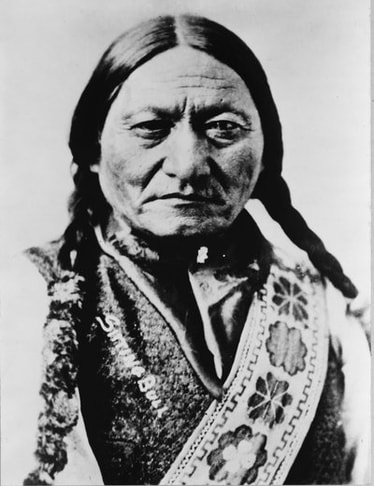|
A meeting is held between the two men and the Great Chief refuses to surrender his people and move to reservation land. Colonel Miles views the chief's decision as stubborn defiance and steps up his campaign against the people.  Photo from the Library Of Congress Photo from the Library Of Congress In 1877, under increased pressure from Colonel Miles and the U.S. military, Sitting Bull, who had been consistently on the move with his people, leads them into Canada. Settling in a place called Wood Mountain, they once again find the free life they love, with buffalo to hunt without fear of attack by the U.S. Army. In the latter part of 1879 things changed for them. The buffalo no longer ranged that far north because the U.S. Army set fires to keep them south of the border. With knowledge of the state the Indians were in, the U.S. Government offered amnesty and food to the Sioux. Emissaries for the United States government began to cause discord by telling the young Lakota that the Indians were enjoying reservation life in the United States. There, food was distributed and they were allowed to hunt with primitive weapons. Both appealed to the young, and discord began to grow. It started with trouble between different groups of young men as they began to cause trouble with other tribes in the area. The white population began to complain of trespass and even losing cattle to the Indian, and the Mounties found themselves in the middle of disputes.
Sitting Bull was losing favor as individuals and small groups began to wander south of the border in response to the promises received, until only a few hundred remained in Canada. The chief requested rations from the Canadian Government and was turned down. Faced with the possibility of starvation for his followers, he found himself in an untenable position. The highly respected chief made a decision. In 1881, with a guarantee from the government that he would not be harmed, Sitting Bull led the majority of what remained of his people back into the United States. Some elected to stay at Wood Mountain; those that returned with him were mostly the old and those that were ill. Upon his surrender, his followers were sent to the Standing Rock Agency at Fort Yates while they relocated Sitting Bull to Fort Randall, on the south side of the Missouri River just north of the Nebraska border, where they held him prisoner. Finding favor with the soldiers at Fort Randall, he was treated with respect; when they determined that he had not been a combatant at the Little Bighorn, he was released to Fort Yates. The agent at Fort Yates, James McLaughlin, being afraid of Sitting Bulls influence, made his life as miserable as he could while he planned for his removal from the reservation. With the entire country aware of Sitting Bull’s deeds, a deal was struck with Bill Cody’s Wild West Show in June of 1885. Much to McLaughlin’s displeasure, virtually overnight, the chief became popular with a broad swath of people, mostly white. A few months of traveling with the show and tiring of the routine, the great chief called it quits in October and returned to the Standing Rock Agency where his people welcomed him back, many coming to him for advice, again much to the chagrin of James McLaughlin.
0 Comments
Leave a Reply. |
AuthorAt seventy-nine, I’m at the beginning of a new chapter in a life filled with blessings from above, adventure, love of family, and kinships reaching into the heavens and to God himself. —AND— I love to tell a story. Archives
May 2021
Categories |
|
 RSS Feed
RSS Feed
